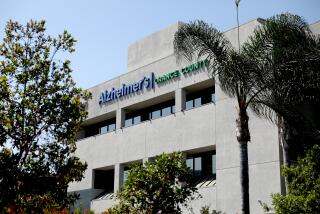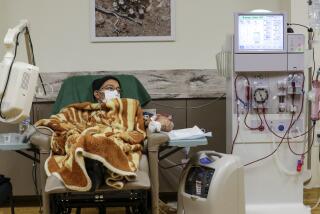Dialysis Patients Face Greater Risk of Cancer, Study Finds
- Share via
If your kidney has failed, you have to have either dialysis or a kidney transplant to keep you alive. But new evidence now indicates that both of those life-saving procedures increase your risk of getting cancer. Researchers already knew that transplants increase cancer risk because of the use of immune-suppressing drugs, which leave patients susceptible to cancer of all sorts. Now a study in Saturday’s Lancet indicates that dialysis is a problem as well.
Researchers from the European Institute of Oncology in Milan, Italy, studied the records of 831,804 patients whose medical records are kept in dialysis registries in Europe, Australia, New Zealand and the United States. They found that 3% of the patients developed cancer during an average of 2 1/2 years of follow-up, whereas only 2.6% of people in the general population developed tumors--an increase in risk of more than 15%. The risk of cancer was especially high in those patients younger than 35. The most common tumors were cancers of the kidney, bladder, tongue, cervix, vagina, penis and thyroid gland.
Drug Therapy as Good as Balloon Angioplasty
Aggressive therapy with cholesterol-lowering drugs is at least as effective as balloon angioplasty in treating patients with mild coronary artery disease, according to new results in Thursday’s New England Journal of Medicine.
The patients in the trial had one or two arteries that were at least 50% blocked and low-density lipoprotein levels of at least 115 milligrams per deciliter. (For patients with heart disease, LDL should be below 100 mg/dl.) They also did not suffer disabling chest pain and were able to complete at least four minutes on a treadmill or bicycle test.
Dr. W. Virgil Brown of the Emory University School of Medicine and his colleagues at 37 medical centers studied 341 such patients. About half received aggressive cholesterol-lowering therapy with atorvastatin (trade-named Lipitor) and half received balloon angioplasty followed by conventional therapy, which often included heart drugs such as ACE inhibitors and aspirin. In balloon angioplasty, a tiny balloon is inflated in the artery at the site of the blockage to open it wider.
The team found that 13% of those receiving atorvastatin went on to suffer a coronary event, compared with 21% of those undergoing angioplasty. Such events included cardiac arrest, nonfatal heart attack, stroke, bypass surgery or death. Furthermore, even for those in the atorvastatin group who did undergo such an event, its onset was significantly delayed.
Study: Longer Walks Beneficial to Heart
Elderly men who walk more than 1 1/2 miles per day have only half the heart attack risk of those who walk only a quarter of a mile, according to a study of Japanese Americans in the Honolulu Heart Program. The program is studying more than 8,000 men of Japanese ancestry who live on the island of Oahu.
In this study, Dr. Robert D. Abbott of the University of Virginia School of Medicine and his colleagues examined a group of 2,678 men, ages 71 to 93.
They report in the July issue of Circulation: Journal of the American Heart Assn. that there were 41 heart attacks among the 805 men who walked less than a quarter of a mile per day and 48 among the 1,067 who walked one-quarter to 1 1/2 miles per day, compared with only 20 among the 806 men who walked more than 1 1/2 miles.
Walking reduces heart attack risk by reducing blood clots, irregular heartbeats and the buildup of fatty deposits in arteries.
Treatment for Muscle Disorder Protected Rats
Israeli researchers have developed a new treatment for a myasthenia gravis-like disease in rats that could soon be submitted for trials in humans. Myasthenia gravis is caused by a genetic defect in which the immune system attacks receptors in muscles that bind the neurotransmitter acetylcholine.
As the receptors are blocked by antibodies and progressively destroyed, nerve-muscle communications are impaired and the patient develops weakness of the muscles of the face, throat and limbs. The disease can be fatal. Patients are generally treated with immune-suppressing steroids, which have a variety of severe side effects.
Immunologist Sara Fuchs and her colleagues at the Weizmann Institute produced genetically engineered fragments of the acetylcholine receptor. They reported in Tuesday’s Proceedings of the National Academy of Sciences that administering the fragments to specially bred rats via nosedrops protected the animals against the onset of the disease. It also led to improvement of symptoms when given to animals in which the disorder had already developed.
Mental Functions Do Not Age, Study Shows
Loss of mental functioning is not a normal result of aging, according to a new study from the UC Davis School of Medicine. In fact, more than 70% of the elderly retain full mental functions as they get older, Dr. Mary N. Haan and her colleagues reported in Wednesday’s Journal of the American Medical Assn.
The exceptions were people with high levels of atherosclerosis (hardening of the arteries) or diabetes and those with the apolipoprotein E4 gene that is associated with an increased risk of Alzheimer’s disease. Both atherosclerosis and diabetes reduce the ability of small blood vessels to carry oxygen and nutrients to the brain, as well as to the limbs. Researchers are not yet sure how the APOE4 contributes to loss of mental functioning.
*
Medical writer Thomas H. Maugh II can be reached at thomas.maugh@latimes.com.






